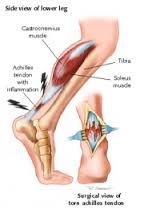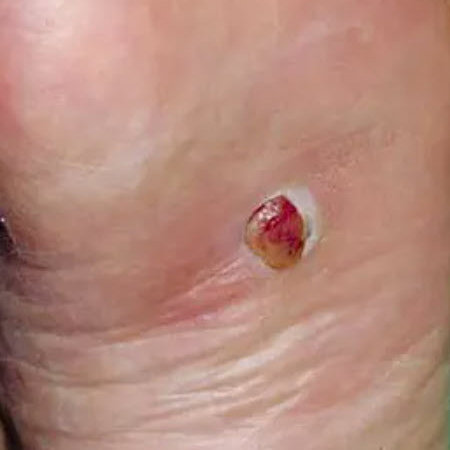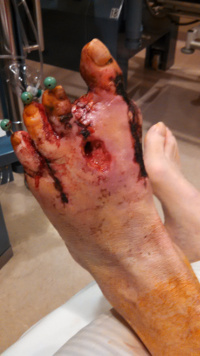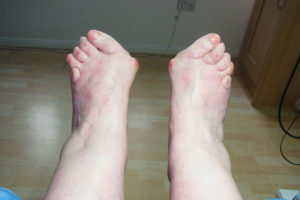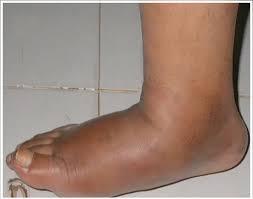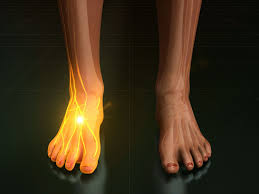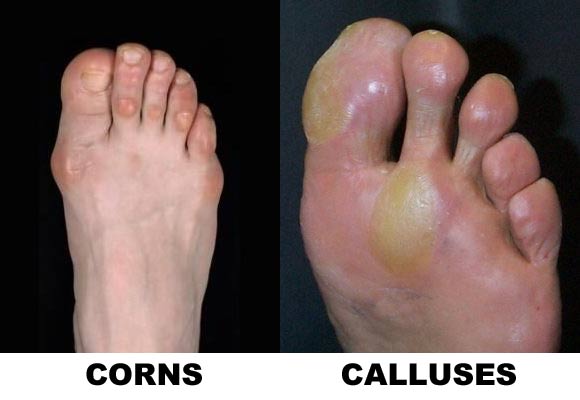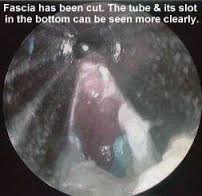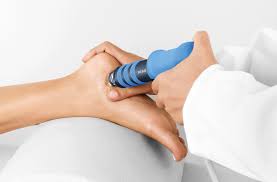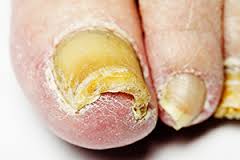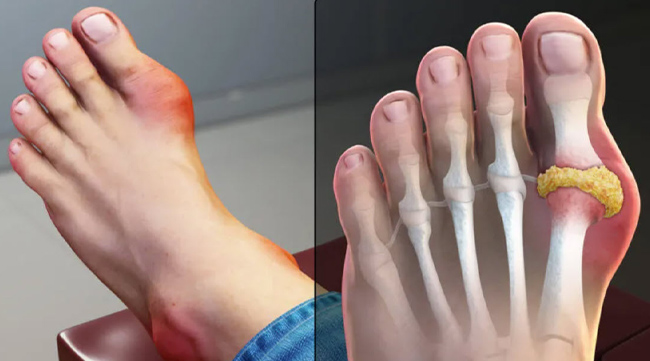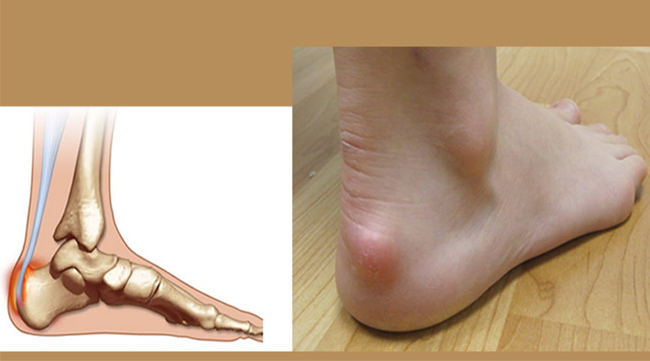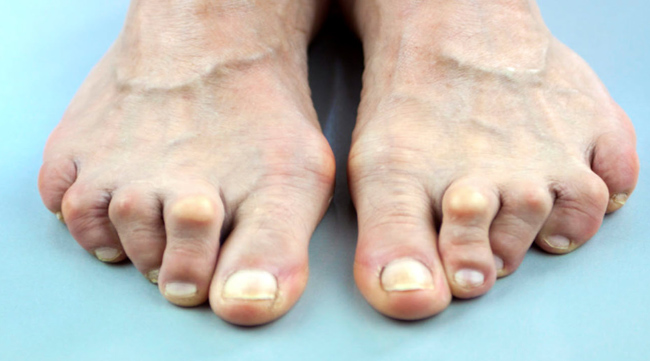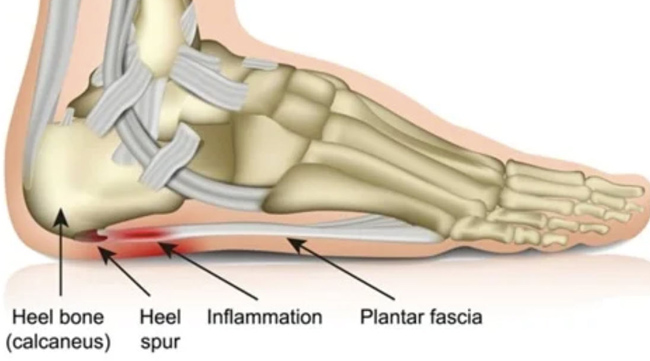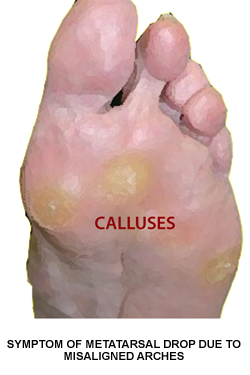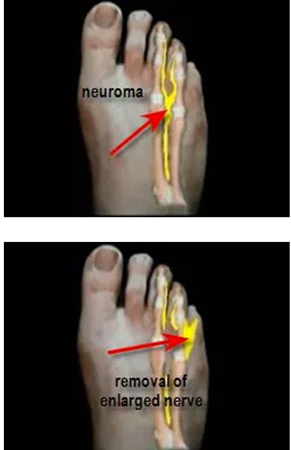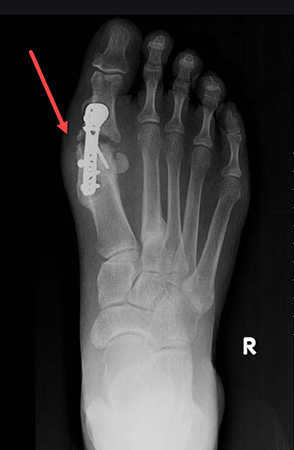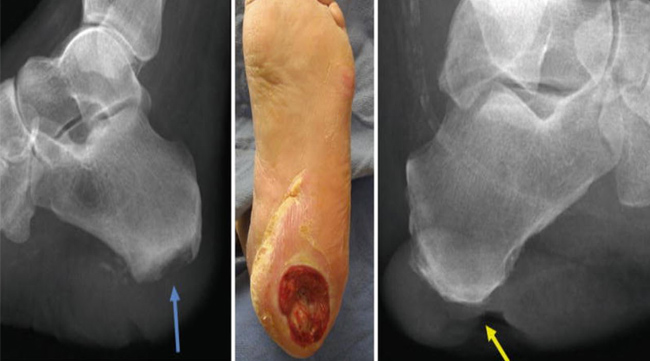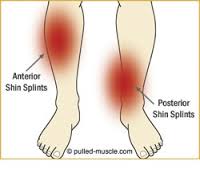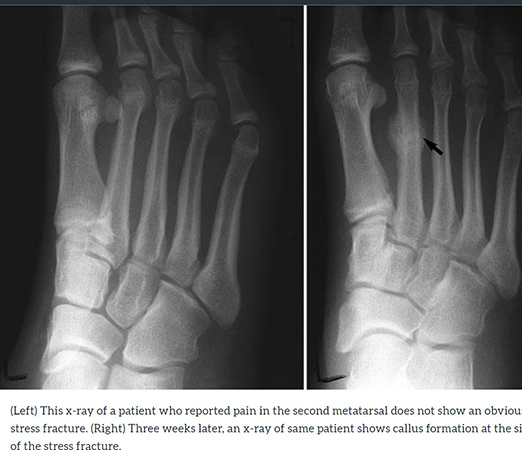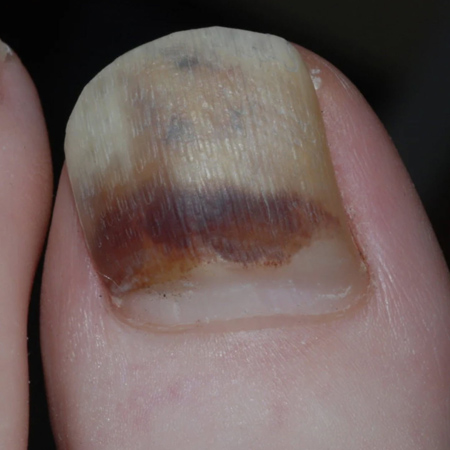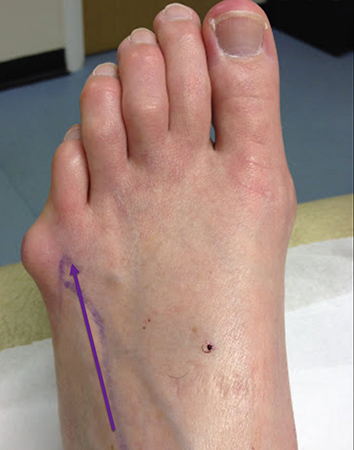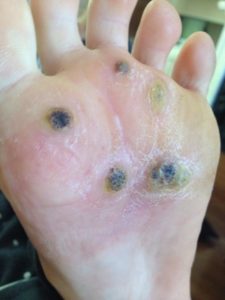DEFINITIONS WITH PICTURES
GLOSSARYAchilles Tendon Rupture
The Achilles Tendon is the heel cord in the back of the heel. Achilles tendons can rupture for many reasons, including age, sex (males are more susceptible), and sports. However, the Achilles Tendon may also rupture secondary to medical negligence – e.g., giving cortisone injections into the Achilles Tendon.
Amelanotic Melanoma
A type of melanoma that is not infrequent but is differentiated by its light color rather than a pigmented dark melanoma.
Arthritis
Artho means joint and itis means inflammation. There are approximately 38 causes of arthritis and most of these conditions affect the human foot. The most common of these conditions is osteoarthritis. This is the simple wearing and tearing away of the cartilage of the joints. Age, excessive weight, ill-fitting shoes and trauma (injury) are the basic causes of osteoarthritis. Fortunately, this condition is very treatable.
Baxter’s Nerve Entrapment
Baxter’s nerve entrapment is a difficult clinical diagnosis and often overlooked in the presentation of heel pain. It can produce symptoms indistinguishable from plantar fasciitis and other causes of heel pain. Of note is that this nerve is often injured when surgery for heel spurs or plantar fasciitis is performed, which can result in severe pain and tingling sensations.
Blood Clot/ Deep Vein Thrombophlebitis (DVT)
Deep Vein Thrombosis (also called DVT) is a blood clot that develops in the leg. This is a serious condition, because it can move to the lungs (pulmonary embolus) and cause death. It can also cause permanent damage in the leg called Post-Phlebitic Syndrome
Bunion
A bunion is a common term for a medical condition known as Hallux Valgus. Hallux Valgus if the tilting of the toe away from the mid-line of the body. It is usually characterized by a lump or bump that is red, swollen and/or painful on the inside of the foot in and around the big toe joint. There are many causes of bunions, but the primary one is tight, ill-fitting shoes, shoes that constrict the forefoot over a long period of time. High heels and constricting forefoot shoe gear are the primary causes of Hallux Valgus.
Charcot Foot and Arthropathy
Charcot foot is a syndrome in patients who have neuropathy or loss of sensation. It includes fractures and dislocations of bones and joints that occur with minimal or no known trauma.​ ​Initially, there may be swelling, redness and increased warmth of the foot and ankle. Later, when fractures and dislocations occur, there may be severe deformities of the foot and ankle, including collapse of the midfoot arch (often called rocker bottom foot) or instability of the ankle and hindfoot.
Complex Regional Pain Syndrome (CRPS)
CRPS is a severe and debilitating condition that occurs when the nerves in the leg “go haywire.” A small traumatic injury such as a slip and fall or any other type of foot, ankle, or leg surgery can ignite this complication. Early and aggressive treatment usually results in complete remission of the symptoms. However, if the diagnosis is not promptly made, or if it is not treated in a timely manner, then the disorder can become severe, debilitating, and often leads to permanent disability.
Corns, Calluses, IPK
Corns and calluses are the most common conditions on the skin of the foot. A corn which is a thickening of the outer layer of skin usually occurs on the tops of the toes. Calluses which are the same condition on the bottom of the feet are caused by sheering pressures. A severe form of callus is considered an IPK (Intractable Plantar Keratosis). These conditions are usually painful and can respond to conservative care.
Cosmetic Foot Surgery
Surgery undertaken solely to for the purpose of affecting the appearance or the size of the foot (e.g., to make the foot smaller to be able to fit into smaller/stylish shoes).
Diabetes: Diabetes is probably the most damaging disease that a patient can encounter with regards to their feet. Diabetes comes in two basic types; type 1 and type 2. Type 1 is usually associated with juvenile diabetes and is usually a hereditary type of disease. Type 2, commonly referred to as adult onset diabetes, is usually characterized by elevated blood sugars by people who are overweight and have not attended to their diet as they should.
Dry Cracked Heels
Dry cracking heels (xeorosis) is a condition of thickening and fissuring (cracking of the bottom part of the heels). In most people this is a nuisance and a cosmetic problem. But when the problem persists, especially in diabetes or people with impaired vascular sufficiency, this can lead to a serious medical problem.
Economy Class Syndrome
Economy Class Syndrome refers to the cramped economy seats on airlines that can give rise to deep Vein Thrombosis, Pulmonary embolus, or death.
Endoscopic Surgery
Endoscopic surgery — endo: meaning the end of, and scopic: meaning to look at — is an instrument that looks at the end of a closed space. When endoscopic surgery is used in conjunction with the foot, it is usually meant to be a procedure that deals with the plantar fascia — plantar: meaning the bottom of, and fascia: the thick ligament that runs from the back of the heel to the front of the foot.
Flat Feet
Flat feet of themselves are not necessarily a problem. But people with a flat foot or the opposite condition, a highly arched foot, that are painful, are certainly in need of treatment. Flat feet and high arches that are associated with ankle, knee or low back pain are also in need of treatment.
Foot Ulcers
Foot ulcers are generally a breakdown of the skin on the plantar aspect (bottom) of the foot. They have many causes, but the most common are diabetes, and vascular insufficiency. Diabetes or vascular insufficiency should be taken very seriously as a good warning sign of impending loss of limb.
Fracture
A fracture is a break in a bone. Fractures are divided into Traumatic Fractures (those fractures that occur as a result of an injury) and Stress Fracture (those fractures that occur as a result of repeated micro-trauma). Fractures take several weeks to heal properly and in some cases, fractures can fail to heal (they develop a “non-union”).
Ganglion
A ganglion is a sac-like swelling or cyst formed from the tissue that lines a joint or tendon. The tissue, called synovium, normally functions to produce lubricating fluid for these areas. A ganglion is a cyst formed by the synovium that is filled with a thick jelly-like fluid.
Gangrene: Dry Gangrene
More common in people with diabetes and autoimmune diseases, dry gangrene usually affects the hands and feet. It develops when blood flow to the affected area is impaired, usually as a result of poor circulation. Wet gangrene almost always involves an infection. Injury from burns or trauma where a body part is crushed or squeezed can rapidly cut off blood supply to the affected area, causing tissue death and increased risk of infection. Gas gangrene: Gas gangrene occurs when infection develops deep inside the body, such as inside muscles or organs. The bacteria releases dangerous toxins or poisons that, along with gas, destroys body tissues.
Gout
Gout (hyperuricemia or elevated uric acid) is generally thought to be a hereditary disease, but there are many causes: increased purine intake (*see diet), sudden weight loss due to dieting, and/or diuretics can cause elevated uric acid and mimic the symptoms of gout. In rare cases, leukemia’s and/or blood dyscrasias can cause elevated uric acid. Gout can be a serious disease and needs medical intervention, generally by an Internist.
Hallux Varus
Hallux varus is a surgical over-correction of a bunion. The big toe splays away from the second toe and the foot can look like a “monkey’s foot.”
Hammertoes / Bone Spurs
Hammertoes, exostosis (bone spurs) could also be grouped under arthritis. Hammertoes, bone spurs, and exostosis are all a result of an imbalance of the muscle structures of the toes, when the toes become crooked, bent, or buckle under causing joints to protrude. These are all descriptions of a biomechanical imbalance.
Heel (Calcaneal) Spur
Although many people with plantar fasciitis have heel spurs, spurs are not the cause of plantar fasciitis pain. One out of 10 people has heel spurs, but only 1 out of 20 people (5%) with heel spurs has foot pain. Because the spur is not the cause of plantar fasciitis, the pain can be treated without removing the spur.
Ingrown Nails / Fungus Nails
An ingrown toenail is a condition in which the nail is cutting into the flesh. This condition is usually very painful and is usually associated with infection of the toe. A nail is ingrown when one or both corners or sides of the nail grow into the skin of the toe. Irritation, redness, uncomfortable sensation of warmth, as well as swelling, pain and infection can result from an ingrown toenail.
Metatarsal Problems / Callus / IPK
In severe cases of calluses, which usually occur on the plantar aspect (bottom) of the foot, an IPK can develop. An IPK is, in medical terminology, an Intractable, meaning that it will not go away, Plantar, meaning bottom of the foot, Keratosis, meaning a deep seated painful callus that usually occurs under a weight bearing metatarsal (long bone of the foot).
Neuroma
A neuroma is an irritated, swollen nerve in the ball of the foot, classically described as a pain in the ball of the foot located between the base of the third and fourth toes. The involved nerve is sometimes squeezed and irritated by these adjacent metatarsal heads causing the painful neuroma to develop. Many people with this condition report feeling a painful catching sensation while walking, and many report sharp pains that radiate out to the two toes where the nerve ends. You may actually be able to feel a swelling between the toes, or a feeling similar to a rock in the shoe. This can feel like electric shocks, similar to hitting your funny bone on the elbow. Current research with Reflex Sympathetic Dystrophy (RSD) has shown a potential relationship between neuroma surgery and RSD.
NSAID – Non-steroidal anti-inflammatory drug
They are called nonsteroidal because they are not steroids, which treat inflammation by suppressing the immune system (inflammation is one of the body’s healing responses to trauma). Instead, all NSAIDs treat inflammation in a way similar to the mechanism of aspirin, the most well-known and oldest member of the class.
Non-Union
Non-union refers to the failure of a bone to “knit” back together following a fracture or surgery. There are many causes of non- union. Non-unions can develop as a result of medical negligence in some instances, such as allowing the patient to walk on the foot too soon.
Orthotics
Orthotics are devices that are used to control abnormal foot function. When the foot is not functioning correctly, it will produce painful areas. The signs and symptoms of altered biomechanics of the foot are usually registered as pain. An orthotic can relieve that pain by supporting the ligaments and the osseous (bone) structures of the feet.
Plantar Fasciitis
Although many people with plantar fasciitis have heel spurs, spurs are not the cause of plantar fasciitis pain. One out of 10 people has heel spurs, but only 1 out of 20 people (5%) with heel spurs has foot pain. Because the spur is not the cause of plantar fasciitis, the pain can be treated without removing the spur.
Reflex Sympathetic Dystrophy
See Complex Regional Pain Syndrome (above).
Shin Splints: A shin splint is technically the tearing away of the anterior tibial muscle from the bone. Shin splints, or tenosynovitis of the anterior tibial muscle (the muscle that runs from the mid portion of the foot up the front of the leg, just below the knee, on the inside front of the calf) is usually caused by over-use. Beginning runners or other people who engage in sport activities who have not sufficiently allowed their muscle tone to build up over a proper conditioning program, or whose conditioning program is too rigorous in the beginning, develop shin splints. However, people with biomechanical, excessive pronation or supination of the foot also develop shin splints.
Stress Fractures
Stress fractures are usually the result of altered biomechanics, in that the structures of the foot are either mechanically not stable and/or the bones of the foot are subjected to repetitive micro trauma.
Sweaty Feet / Foot Odor
Sweaty feet (hyperhidrosis) and smelly feet (bromohydrosis) are two very common, annoying conditions of the feet. While some cases of excessive smelling or sweating of the feet are systemic (throughout the whole body) in nature, such as anemia (low blood count) or hyperthyroidism (overactive thyroid), these conditions are usually of a local cause.
Synovial Sarcoma: Synovial sarcoma is a malignant soft tissue tumor. This tumor is often misdiagnosed as Plantar Fasciitis.
Tailor’s Bunion or Bunionette
A tailor’s bunion, also known as a bunionette, is a bump or prominence on your fifth metatarsal bone, at the base of your small 5th toe. Tailor’s bunions are not really a growth of bone or a calcium deposit. It is the rounded end of the fifth metatarsal bone spreading outward from the center of your body. Painful symptoms often occur due to constricting shoes more commonly worn by women.
Tarsal Tunnel Syndrome
Tarsal tunnel syndrome — tarsal: meaning the lower ankle area of the foot — is a condition that usually affects the medial (inside) aspect of the ankle. There are many structures that run through this area, including tendons, veins, arteries and nerves. Tarsal Tunnel Syndrome occurs when the posterior tibial nerve, as it courses under the ligament at the ankle, becomes inflamed for a variety of reasons, namely: excessive pronation, arthritic problems such as rheumatoid arthritis, trauma, and even obesity.
Warts
Warts, or Verruca(e) are small, grainy skin growths that occur most often on your feet and hands. These are rough to the touch and resemble cauliflower. They can feature a pattern of tiny black dots — sometimes called seeds — which are small, clotted blood vessels. Despite the fact that warts are generally caused by a virus and can be treated, these can be mistaken for foot melanomas and in those cases, can be deadly. See out recent case report as to the negligent diagnosis.
If you or someone you know have experienced medical malpractice... We are available
About Us
The physician-attorneys who are listed on the Footlaw.com website include current and formerly practicing board certified podiatrists.


